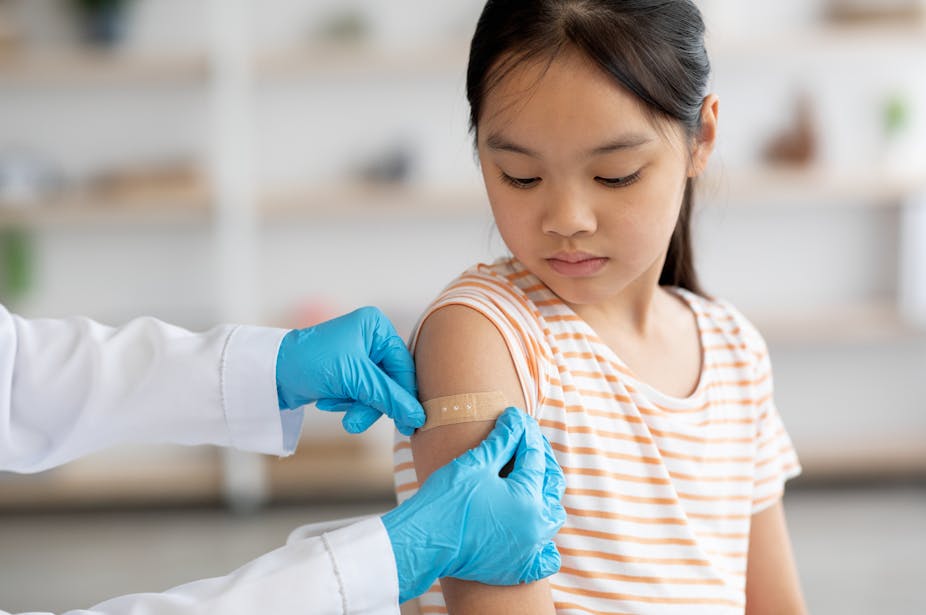The NHS has pledged to eliminate cervical cancer in England by 2040. This will be achieved by amping up current vaccination and screening programmes.
While this goal may seem unrealistic or even impossible, there are many reasons to believe it can be achieved, and in the timeframe NHS England boss Amanda Pritchard has set out.
The cornerstone of the NHS’s strategy for eradicating cervical cancer is its vaccination programme.
This programme has been very successful so far. Around 80% of teenagers in England have already receive the human papillomavirus (HPV) vaccine, which significantly reduces the risk of getting cervical cancer.
This is because HPV, a sexually transmitted infection, is a cause of 99% of cervical cancer cases. The vaccine provides effective protection against the most common, high-risk strains of the virus that cause the cancer.
Targeting adolescents not only ensures a high level of immunity within the population but also a significant reduction in HPV transmission.
Long-term data shows this vaccine has already helped lower the incidence of cervical cancer by 87% in women in their 20s who had been offered the vaccine when they were aged 12-13. With more people getting vaccinated for HPV each year, this will mean every year there are fewer cases of HPV and cervical cancer and fewer deaths from it.
The vaccination programme’s success lies in its accessibility and inclusivity. Schools across the country serve as vaccination hubs, ensuring easy and widespread access for teenagers.
Also, the vaccine is offered for free on the NHS, ensuring that cost is no barrier to protection. The collaborative efforts of healthcare professionals, educators and policymakers have created a comprehensive and efficient vaccination programme.
But vaccination only helps to prevent HPV infections. Another crucial aspect of this elimination pledge will be the UK’s cervical screening programme.
Cervical screening, often referred to as the smear test, is regularly offered to women aged 25 to 64. Screening allows doctors to identify pre-cancerous changes in the cervix caused by HPV.
The programme, which was started in 1964, is estimated to save 4,500 lives per year in the UK. Detecting abnormalities early ensures that people with signs of cervical cancer are treated promptly, stopping HPV from progressing to cervical cancer.

Public awareness campaigns educating people about HPV and cervical cancer have also played a pivotal role in encouraging participation in vaccination and screening programmes and will continue to do so. People who are informed are more likely to take preventative measures.
Potential challenges
Although England is on track, there are still some areas that will need to be addressed to achieve their elimination target.
Addressing socioeconomic disparities will be important, as people living in certain areas may have less access to vaccination and screening services for cervical cancer. Lessons learned from the COVID pandemic may be useful in ensuring equal access to HPV vaccines and screening.
For example, mobile vaccination units, which were used during the pandemic to expand vaccine access, could be useful.
And, despite high vaccination rates, vaccine hesitancy remains a challenge. Misinformation, mistrust of health authorities and concerns about vaccine safety can undermine efforts to achieve universal coverage.
Overcoming vaccine hesitancy and increasing access to the vaccine is integral to eliminating cervical cancer in England. The more people who receive the HPV vaccine, the fewer incidences of cervical cancer.
Although it can take several years for these effects to become apparent, data from countries with high HPV vaccination coverage, including Sweden, the US and Australia, have shown a substantial decline in the prevalence of HPV infections and cervical cancer.
Another benefit of vaccinating a significant portion of the population is that it contributes to herd immunity. This protects even those who aren’t vaccinated, which will further reduce the overall burden of HPV and cervical cancer.
HPV vaccination can also help prevent vaginal and vulval cancers in women, penile cancers in men, and anal cancers in both men and women. It can help prevent head and neck cancers, which are often caused by HPV as well.
Addressing vaccine hesitancy through targeted education and communication strategies is crucial.
The UK’s ambitious goal of eradicating cervical cancer by 2040 is within reach, thanks to the concerted efforts in vaccination and screening. While vaccine hesitancy and health inequalities remain challenges to be addressed, the nation’s strong healthcare infrastructure, public awareness campaigns and government commitment will still help it achieve this milestone pledge.

